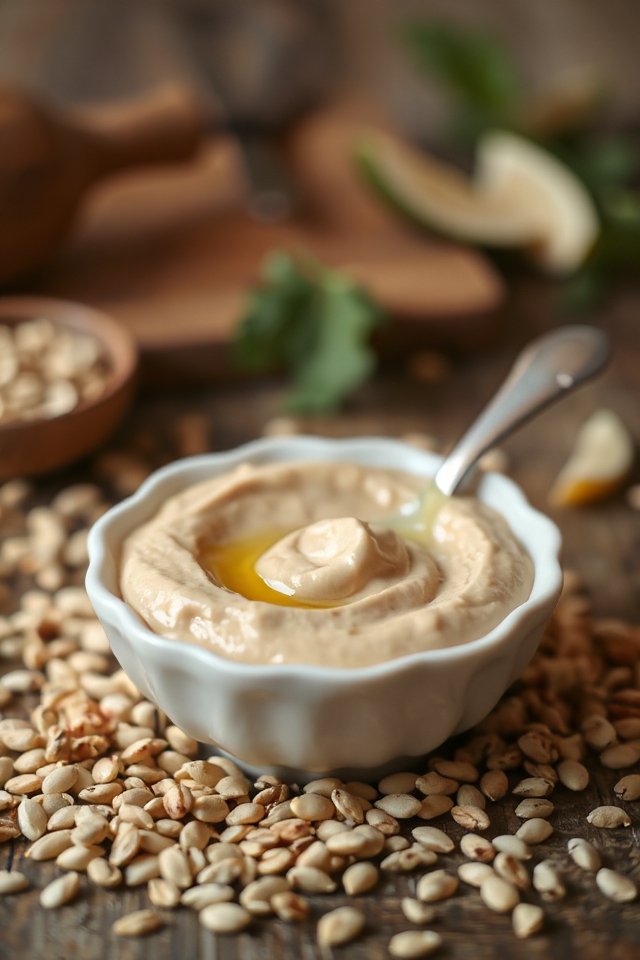Why You’ll Love This Homemade Tahini Recipe
You’ll love this homemade tahini recipe because it’s not only simple to make, but it also brings a rich, nutty flavor to your dishes.
I can’t get enough of its creamy texture, which elevates everything from salads to roasted vegetables. Plus, making it at home means I control the ingredients, ensuring it’s fresh and free from preservatives.
It’s a versatile staple that enhances dips, dressings, and sauces, and I often find myself using it in unexpected ways.
Trust me, once you try this recipe, you’ll wonder why you ever bought store-bought tahini in the first place.
Ingredients of Homemade Tahini
If you’re ready to whip up some homemade tahini, let’s dive right into the ingredients you’ll need. This recipe is all about simplicity and freshness, and I promise, once you gather these items, you’ll be on your way to making a creamy, nutty delight that can transform your meals.
So, what do you need for this tahini magic? Let’s take a look.
- 3/4 lb sesame seeds
- 2 teaspoons peanut oil (plus a little extra for processing)
- 3 tablespoons peanut oil (for that smooth finish)
- A pinch of salt (if you want to add a little flavor)
Now that we’ve our ingredient lineup, let’s chat about them for a second.
First off, sesame seeds are the star of the show. They bring that rich, nutty flavor we all adore, and toasting them really amps up the taste. If you can find them, try to get the unhulled sesame seeds. They’ve a deeper flavor and more nutrients.
As for the peanut oil, it’s what helps achieve that silky texture that makes tahini so dreamy. Don’t worry if you don’t have peanut oil; you can substitute with another neutral oil like canola or grapeseed oil. Just keep in mind that the flavor might shift a bit.
And that pinch of salt? Totally optional! But honestly, it can elevate the taste if you’re looking for that extra oomph.
How to Make Homemade Tahini

Alright, let’s get into the nitty-gritty of making your own homemade tahini. First things first, preheat your oven to 350°F.
While it’s warming up, grab that 3/4 lb of sesame seeds and spread them out on a baking sheet. Now, here’s where the magic begins: toast those little seeds in the oven for about 20 minutes, or until they’re lightly roasted. You want them to be golden and fragrant, but not burnt.
Seriously, burnt sesame seeds aren’t a vibe—trust me, I’ve been there. Keep an eye on them to avoid any culinary disasters.
Once your seeds are perfectly toasted, it’s time to get blending. Toss those seeds into a medium-sized food processor and process them for about 3 minutes. You might be thinking, “Is this really going to come together?” Yes, yes it is. Just keep the faith.
After the initial processing, add in 2 teaspoons of peanut oil. This will help create that rich, creamy texture we’re after. Blend on high for another 30 seconds.
Now, here comes the silky part: add 3 tablespoons of peanut oil and process until it’s oh-so-smooth—think 2 more minutes of blending. If you’re feeling a bit adventurous, sprinkle in a pinch of salt to enhance the flavor.
And voilà, you’ve got yourself some homemade tahini that’s ready to elevate your dishes like a pro chef.
Homemade Tahini Substitutions & Variations
Ever wondered what you can use as a substitute for tahini or how to mix it up for different flavors?
If you’re in a pinch, you can try almond butter or sunflower seed butter; both work well in recipes calling for tahini. For a twist, I love adding a splash of lemon juice or garlic for extra flavor.
You can also experiment with different oils, like olive oil, to change the taste profile. If you want a nut-free option, blending cashews with a bit of water can create a creamy alternative.
Get creative and find what suits your palate best!
What to Serve with Homemade Tahini
While tahini might be the star of your dish, it pairs beautifully with a variety of foods that enhance its nutty flavor.
I love drizzling it over roasted vegetables, like sweet potatoes and cauliflower, which really bring out its richness.
It’s also fantastic in salads, adding a creamy texture to greens and grains.
Try it as a dip for fresh veggies or pita bread; the contrast is delightful!
You can even mix it into hummus for an extra layer of flavor.
Trust me, once you start experimenting, you’ll find endless ways to enjoy this versatile ingredient!
Additional Tips & Notes
To guarantee your homemade tahini turns out perfectly, I recommend using high-quality sesame seeds as they greatly influence the flavor and texture.
Make sure to toast them gently, watching closely to avoid burning. If you want to experiment, try blending in a bit of olive oil for a unique taste.
For a creamier consistency, don’t hesitate to add a little water while processing. Store your tahini in an airtight container in the fridge, and it should last for a few weeks.
Finally, taste and adjust the salt to your liking—it can make all the difference in enhancing flavors!